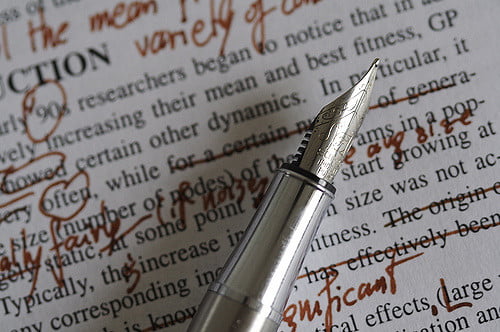Of Comma Splices, Red Pencils, and Holden Caulfield: Why Collaborative Editing is Important to the Grant Writing Process
You know the grimace you make when handed an edited draft of a grant you’ve been working for weeks on and it’s filled with red pencil markups (or track markups as the case may be). Your reaction probably harkens back to your days in high school when red pencil marks adorned your impassioned paper on “Catcher in the Rye” with phrases like “run-on sentence”, “passive voice”, and “more detail”. This experience makes many people reticent to share their work with others and omit the important role a great editing process can provide. Editing a grant is often left until the last minute and is frequently given to the person on staff who has the best working knowledge of semi-colons rather than capitalizing on the in-house talent of your staff, board members and volunteers to help refine and polish a grant application. So here are a couple of tips to make the process effective, integrated into the writing process, and collaborative:
Step One- Develop a Timeline – When developing the grant writing timeline, build in time throughout the process for editing drafts of the grant. This will ultimately reduce the number of rewrites down the road and help reduce the tunnel vision writing that often happens when you approach a grant deadline.
Step Two – Assemble an Editorial Team – Recruit an editorial team that includes:
- An expert in the field. This person knows the language of the funder and knows the latest research in the field.
- Quality Control – The person who knows the style the grant is supposed to be written in. This person makes sure that the narrative matches the RFP and that the budget and program description are in alignment.
- A staff member who will work with the grant program /purchase/product if funded. This is your reality checker. The person who will say “you are promising too much” on this proposal or, “we need to put more funding in this section of the budget.“ This is the person who can bring the client voice into the writing process. Additionally, this person should also be the person who can readily connect the organization’s mission to the grant request.
- The Greek Chorus – Someone who isn’t intimately involved in the process who can bring a set of fresh eyes to the process. This person should not participate in Step Three.
Step Three – Identify the Goals and Purpose of the Grant. Make sure the Editorial Team is clear about what the purpose of the grant is, what the product of the grant is, and how this product will affect the people you serve. This material can also be shared with people writing letters of support for your grant. This will ensure that your grant application is comprehensive and consistent.
Step Four – Your Editing Toolbox. Work with your Editorial Team to:
- Finalize a grant timeline
- If necessary, agree on proofreading marks – The Chicago Manual of Style has a great summary of editorial marks.
- Agree on how you want to share drafts of the grant (Dropbox, Google Docs….or even old-school hard copy).
- Agree on who has the final say when an editorial disagreement might arise. I suggest that when in doubt, Strunk and White’s Elements of Style is still the final word on grammar and what constitutes good writing.
Step Five – Editing Mantra. When editing, encourage your editorial group to select at least three things the reviewer finds really well written, then be very specific about what needs to be revised and always end with why what the person has written is important. It’s as important to point out what’s working and really telling the story as it is to point out what isn’t clear and needs revision.
Step Six – Share a final copy of the grant with the team and be sure to let them know the outcome of the application. Ask for feedback on the process and how it could be improved and if any other grant ideas were generated from the review process. The grant writing process often sparks great ideas for other opportunities as well as a deeper appreciation for the grant writing process.
Don’t forget to share your journey on the 30-Day Grant Readiness Challenge by using the hashtag #grantreadiness on your posts and updates on social media.
Did you miss the launch of the 30-Day Grant Readiness Challenge? It isn’t too late for you to start! It’s free and you can sign up at any point and it will start you back on Day 1!

